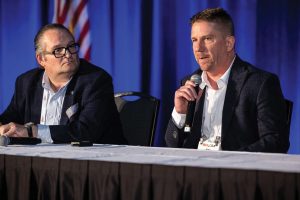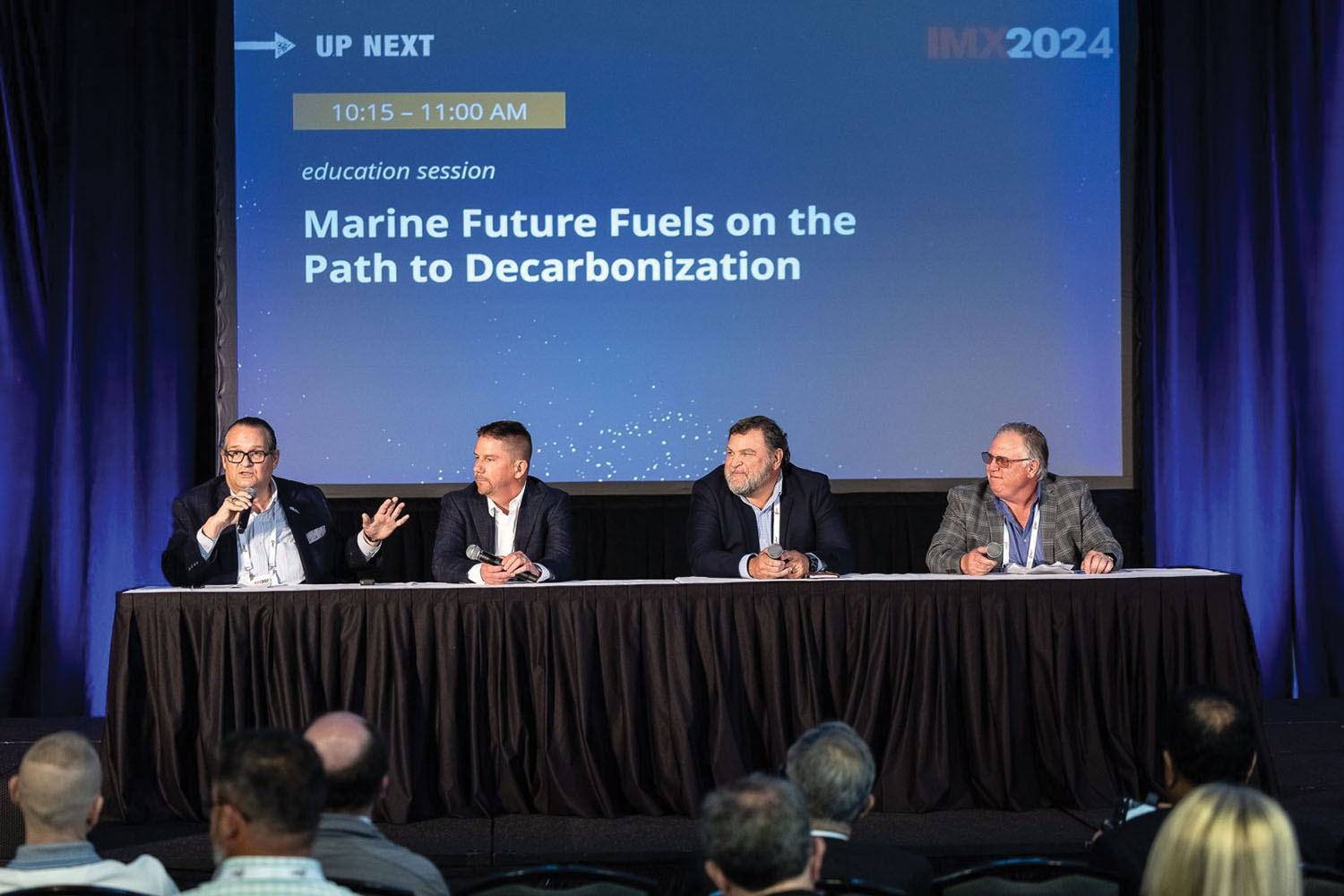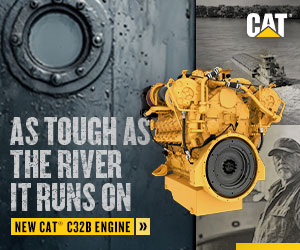Towboat operators looking to cut vessel emissions and boost efficiency have options available to them now, and even more are on the horizon. That was the takeaway of a panel of experts speaking on “Marine Future Fuels on the Path to Decarbonization” as part of IMX 2024, held May 29-31 in Nashville, Tenn.
What’s driving that shift toward low-carbon energy sources? And can it be economically feasible? Those are two of the questions that Tony Odak, chief operating officer of John W. Stone Oil Distributors, posed to the other panelists, which included Mike Complita, principal and vice president of strategic expansion for Elliott Bay Design Group; Gary Sarrat, tug and inland waterways account manager for Caterpillar Inc.; and Brian Rafferty, vice president of business development and sustainability at Marquette Transportation Company.
Complita said he doesn’t see inland-specific regulations driving decarbonization efforts. Rather, regulations and mandates in other regions may indirectly affect the inland market. Regulations put in place by the California Air Resources Board (CARB) are a major driver.
“That’s obviously driving massive change on the West Coast,” Complita said. “We’re also starting to see Washington and Oregon follow that lead. They’re proposing legislation to follow and adopt similar rules.”
Complita said he’s heard rumors that New York and even Texas are considering similar air pollution restrictions.
“So my expectation is that, in very short order, we will start to see those regulations in the coastal states,” Complita said, “with the changes they make moving their way into the inland river system.”
Already, some inland and coastal ports have put “net zero” goals in place, with year targets like 2040 or 2050, Complita said.
“I do think that, even without the regulations, we’re going to see a lot of interest in some of these new technologies and really pushing toward that in the next five to 10 years to make those goals,” he said.
And while crafting and passing a mandate or regulation might not take too long, the research and development required for an engine to meet that regulation does take time. Sarrat offered the engine tier system from the Environmental Protection Agency (EPA), which was phased in over many years, as an example.
“Different regulations … are not necessarily aligned with what the U.S. EPA is doing,” Sarrat said. “So as an engine manufacturer, it presents quite a challenge, and I wish that we could put all our R&D in one place, snap our fingers and have the technology ready for you in advance. We’re doing our best to do that, but it is difficult to take an engine platform and technology adapted to the particular regulatory needs of a certain region, and then get that proven, fleshed out, tested and certified. That process does take a little while.”
Rafferty, speaking from an operator perspective, underscored each panelist’s—and more broadly each maritime company’s—commitment to find a way “to decarbonize in a safe and reliable way.” More than that, he challenged those present to remember one of the strengths of the maritime industry.
“We have to keep in mind that inland marine transportation is the greenest form of transportation already,” he said. “And we actually have a relatively small footprint in the overall scheme of things, so there is a perspective that needs to be maintained here.”
Rafferty added that, so far, Marquette hasn’t had end users come to the table to pressure the company into a radical change in operation.
“That pressure doesn’t exist, and so until that happens, we’re going to continue to be cautious, studious observers, trying to find the right solution for our operations and people and move forward that way,” Rafferty said.
Odak said that approach bears some similarities to John W. Stone’s, which dates back to 2014 when the company began to “tier up” the engine packages in its fleet. The company later went down the road of biodiesel and shore power, and most recently it secured a ratable supply of renewable diesel, which is a drop-in fuel that’s indistinguishable from conventional diesel but derived from renewable feedstocks.
“By August, we should be at a million gallons of renewable diesel, which should, generally speaking, reduce our greenhouse gases by 75 percent,” Odak said.
Odak said that, for John W. Stone at least, the effort to decarbonize was driven by internal and external forces and not by subsidies, like in other parts of the country.
Odak then turned the conversation to drop-in fuels easily available now versus so-called alternative fuels, like methanol and ammonia. Sarrat offered an all-of-the-above approach.
“There is no one silver bullet for the industry or for a particular marine operator to decarbonize,” Sarrat said. “It really depends on your operations, your vessels, the capability of your people on board the vessels. Those things are very important.”
For some vessels, a hybrid system might work. For others, the solution may be biodiesel, which has to be part of a blend, or renewable diesel. Other companies may have the means and logistical capability to look at using methanol, ammonia or an all-electric system.
“As we work through this and develop technologies, it’s imperative that you work with us, we work with you, to understand your particular operation,” Sarrat said. “Let’s sit down and talk about what’s a good fit for your operation. It may not be one path. It may be entirely another path that we’re working on that makes sense. And it may be that you have multiple paths in your fleet, depending on the type of boats that you have. That’s why at Caterpillar we’re working on multiple paths with alternative fuels, multiple ways to turn that propeller and create less carbon while we do it.”

Methanol has been generating a lot of headlines, and Sarrat said Caterpillar is well on the way to bringing a methanol-burning engine to market. The company has been running methanol engines at its testing center in Peoria, Ill., for a few years. Caterpillar is also working with Damen Shipyards to develop a methanol dual-fuel 3516E engine, with plans to deploy that in 2026.
Complita then described Elliott Bay’s work in the methanol space, particularly the Hydrogen One project, which is a partnership between Elliott Bay, American Commercial Barge Line and Maritime Partners. Complita shared a graphic comparing a traditional towboat, a towboat running on pure hydrogen and the Hydrogen One, which will feature a methanol-hydrogen reformer that will then power a fuel cell. Using the methanol-hydrogen reformer will allow Hydrogen One to essentially fit within the general footprint of a traditional towboat, whereas running on pure hydrogen would require a much larger vessel.
“It’s just impractical,” Complita said regarding a pure hydrogen application. “That thing is longer than one of the barges it would be pushing. It would be heavy, and it would be probably $40 to $50 million to build that towboat. So when people see that [graphic] they’re like, whoa, OK, now we get why we can’t do hydrogen.”
Energy density is also a concern, with methanol and ammonia having about half the energy density of diesel. In addition, ammonia has to be stored under pressure, which adds to the complexity of the vessel design.
“Whatever the case may be, energy density is the No. 1 driver of cost, weight, size and volume of everything that’s making these new vessels so expensive and so complex,” he said.
While regulations, mandates and other internal and external forces are driving a shift to low-carbon energy sources, and while engine manufacturers ramp up research and development, agencies like the Coast Guard are grappling with how to license and permit those projects. At the same time, operators have to consider crew competencies in terms of operating and maintaining the new systems and safely handling new kinds of liquid fuel.
Sometimes, it’s easy for the simple things to get lost in the fray, Complita said.
“What can we be doing on an incremental basis?” he said. “That is one thing that I think is really important to consider.”
For a very low cost, Complita said, operators can install equipment to monitor and optimize engine performance and anticipate maintenance issues before something breaks. Complita said he’s heard that captains sometimes are reluctant to throttle back a small amount, which can actually save a significant amount of fuel burn over time. A way to get buy-in, Complita said, is to “game-ify” that situation.
“Have a challenge among your masters and say, ‘Hey, anyone who saves the most amount of fuel this month, or whatever, gets some kind of award,” he said.
Bottom coatings can also achieve greater efficiency and, as a result, reduce emissions. A 2 percent or 5 percent reduction may not sound like a lot, Complita said.
“But that’s a huge change,” he said, later adding, “We really need to be looking at and implementing together these little, smaller steps to make changes now that add up over time.”



